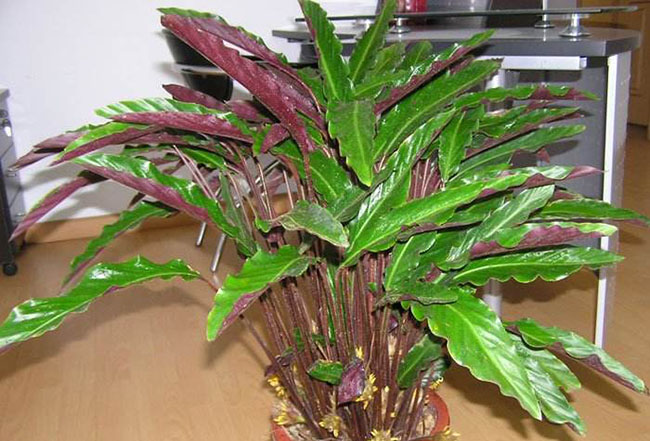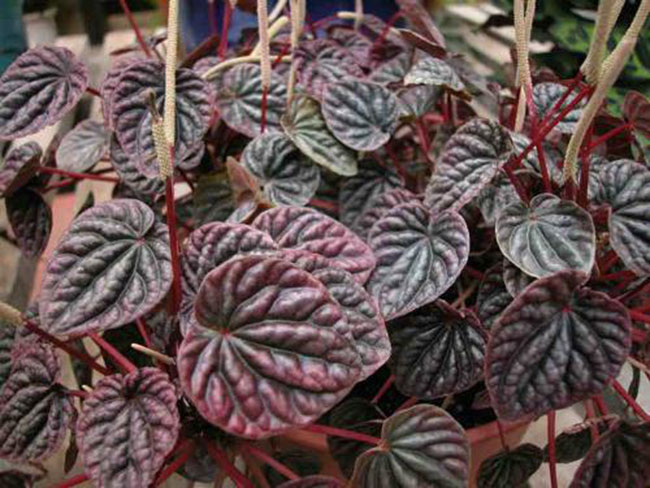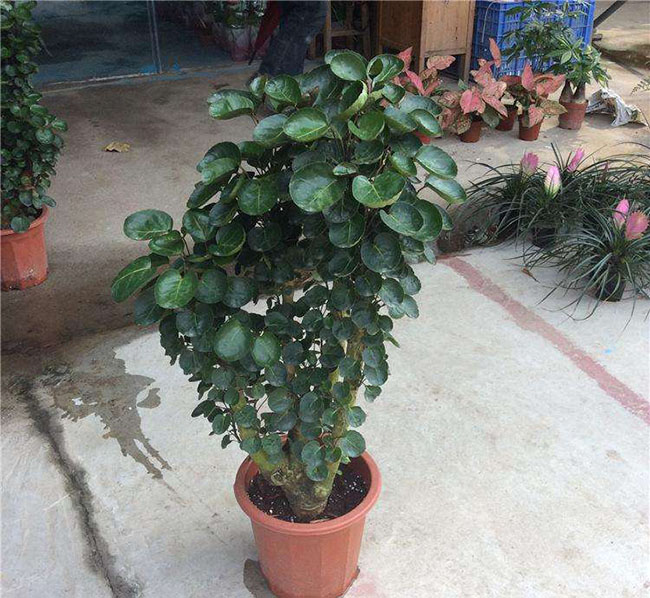Culture methods and matters needing attention of red-backed bamboo taro
Growth habits of red-backed taro
Red-backed taro likes to grow in a warm, humid, shady environment, not cold-resistant, afraid of drought, avoid strong light exposure. The suitable temperature for growth is 20-30 ℃, and the overwintering temperature is 15 ℃. The sandy soil which is rich in humus and has good permeability is suitable for culturing red-backed taro.

Propagation method of red-backed bamboo taro
1. Ramet propagation:
Red-backed bamboo taro should be carried out after the temperature warms up in spring, and the plants with exuberant growth can be divided into pots every 1-2 years. The tufted plants were cut into several clumps along the growth direction of underground rhizomes, then planted in pots, preserved in a shady place, and managed according to conventional methods after rooting.
2. Cutting propagation:
Cuttings can be cut off the upper internodes of the mother plant in the mildew and rainy season and planted in rotten leaf soil or peat to be potted after rooting. Pay attention to spraying water to the leaves during the growing period, fertilize once a month, and put in shade in the middle of summer to avoid strong light exposure. There should be no water in the basin, and the yellow and dead leaves should be cut off in time. Sufficient sunshine is needed in winter and watering should be reduced appropriately.
Culture method of red-backed bamboo taro
1. Soil:
Planting red-backed taro requires rich nutrition, loose and breathable soil. The pot culture of purple back bamboo taro can use rotten leaf soil, garden soil and river sand as culture soil and a small amount of base fertilizer as culture soil.
2. Lighting:
Red-backed taro is an excellent indoor shady foliage plant. 70% of 80% of the light should be covered in summer to avoid sunlight exposure, otherwise the leaves of red-backed taro will fade and lose their luster, which will seriously cause sunburn. When breeding red back taro, it is not suitable to put it in a dark and poorly ventilated place for a long time, so as not to cause the phenomenon of leaf yellowing and shedding.
3. Temperature:
Red-backed bamboo taro likes warm, humid and shady environment, the suitable temperature for growth is 20-30 ℃, and the overwintering temperature is 15 ℃.
4. Watering:
In the red back taro growth period should be fully supplied with water, keep the basin soil often moist, when the basin soil is slightly dry should be timely watering. Often spraying water on and around the leaves can increase the humidity of the air and make the red-backed taro grow better. However, we should be careful not to make the basin soil stagnant, so as to affect the growth and rotten roots, especially the amount of water should be controlled after autumn.
5. Fertilization:
In the growing season, liquid fertilizer is applied 1-2 times a month to ensure its robust growth and luxuriant branches and leaves. In addition, in order to make the red back taro grow well, the pot can be turned every 1-2 years.
6. Control of diseases and insect pests:
The main diseases in red-backed taro culture are leaf spot and leaf blight. In the early stage of the disease, 200 times Bordeaux solution can be sprayed 2-3 times every half month. It can also be sprayed with 600 times solution of 65% Dysen zinc wettable powder. In addition, if the ventilation is poor, red-backed bamboo taro may have shell insect pests, which can be sprayed with 1000 times of fenitrothion EC in the nymph stage.
The function of red-backed taro
Red-backed taro is mainly potted for interior decoration and is an excellent ornamental plant for leaves and flowers. Decorate the red back taro in the bedroom, living room, office and other places, appear quiet and dignified. And red-backed taro is a perennial evergreen plant, which can be cultivated indoors for long-term appreciation.
Cultivation methods and matters needing attention of purple-backed bamboo taro in pot culture
Purple-backed taro is a kind of plant commonly used to beautify the home environment, enhance the style of public places and improve air quality. Generally speaking, the methods and techniques of planting purple-backed taro are not much different from those of other taros. As long as you can do these basic things well, you can usually achieve better growth.
How to raise purple back bamboo taro in pot
Purple-backed taro likes a warm, humid and shady environment. The suitable temperature for growth is 20-30 ℃, it needs more water, and it is not resistant to drought, heat and cold. It can survive the winter safely above 5 ℃. Purple back taro is afraid of frost and likes acid soil that is loose, fertile, moist and well drained.
Culture methods and matters needing attention of Amorphophallus sinensis
1. Temperature and light
Amorphophallus angustifolia prefers high temperature, humid and semi-shady environment, the suitable growth temperature is 20-30 ℃, and the safe overwintering temperature is 10 ℃. Guard against high temperatures in summer and cold in winter. Purple-backed bamboo taro bothers direct sunlight and grows better under indirect radiation or scattered light. Otherwise, it will lead to leaf yellowing and loss of luster, especially in summer, but it should not be placed in dark and poorly ventilated places for a long time, so as to avoid leaf yellowing and shedding.
2. Water and fertilizer management
The purple back bamboo taro is not tolerant to drought and requires a large amount of water, so it must be given sufficient water in the growing season to keep the basin soil often moist, but we should pay attention not to make the basin soil stagnant water, so as to avoid rotting roots. In summer and autumn, when the temperature is high and the air is dry, water is often sprayed to the leaves and around to maintain high air humidity. The temperature is relatively low after the end of autumn, so it is necessary to control the amount of watering and keep the basin soil slightly wet.
In the growing season, liquid fertilizer can be applied twice a month to ensure its robust growth and luxuriant branches and leaves. Amorphophallus mandshurica is a foliage plant. Proper application of nitrogen fertilizer can make the leaves more beautiful. However, it should be noted that the amount of fertilizer should not be too large.
3. Breeding taboos
Purple-backed bamboo taro is an excellent indoor shady foliage plant. In order to prevent sunlight exposure in hot summer, 70% of the light should be blocked, otherwise it is easy to cause injury. If the air humidity is low and the basin soil is dry, the edges of leaves will turn yellow and scorched. In addition, direct sunlight will also cause the edges of leaves to turn yellow and scorched.
4. Methods of reproduction
The propagation methods of purple back taro are mainly plant propagation and cutting propagation.
5. Diseases and insect pests
The common diseases and insect pests of purple back taro are white silk disease, leaf spot, shell insect, red spider and so on.
Ramet propagation of Amorphophallus angustifolia
With the growth of purple back taro, the plant is getting bigger and bigger. If the growth is exuberant, the pot will be changed every 1-2 years. Therefore, it can be combined with changing pots for ramet propagation. When the temperature picks up in spring, ramets can be carried out throughout the year if the temperature and humidity are suitable.
Remove the plant of the purple back taro to the pot and soil, and cut the clump of plants along the growth direction of the underground rhizome with a knife, preferably with stems and leaves or leaf buds. It can be divided into several clusters and then planted in pots. The planted taro was preserved in a shady place to control moisture, and the water could not be watered until normal growth was restored.
The value of Amorphophallus sinensis
1. The ornamental value of purple back taro.
Purple-backed bamboo taro is a kind of foliage plant, its branches and leaves grow luxuriantly, the plant shape is plump, the leaf surface is dark green and shiny, the leaf color is rich and colorful, it is a kind of highly ornamental plant, which is mainly used as indoor ornamental potted plant.
2. Indoor pot culture value and leaf cutting value of purple back taro.
Because of its beautiful plant type, colorful leaves, strong shade tolerance and simple cultivation and management, it can be used for indoor potted ornamental plants. It is one of the most famous indoor foliage plants in the world.
The large variety of purple back bamboo taro can be used to decorate hotels, shopping malls and other large space, while small varieties can decorate the balcony, living room, bedroom and so on. In the process of cultivation and management, every time it is placed, it should be placed on the balcony, windowsill where the sun is strong, enhance the light, in order to facilitate long-term viewing.
Due to the purple back taro leaf color, with eye-catching markings, very beautiful, is a high-grade leaf cutting material, can be directly used as flower arrangement or as a lining material.
3. The edible value of purple back taro.
Purple back taro rhizome contains starch, can be eaten, it also has the role of clearing lung heat, diuresis and so on.
Purple back taro can not only be used for ornamental and leaf cutting and other market value, but also has a certain role in food and dietotherapy. The starch in the root of purple back bamboo taro can not only be eaten directly, but also clear away heat and diuresis, which is very beneficial to the daily recuperation of the body. Friends who have planted purple back taro can try it!
The function of Amorphophallus mandshurica Culture methods and matters needing attention
Purple-backed taro is an excellent indoor shade-loving foliage plant. Do you know about it? What is the function of purple back taro? Today, let's talk about the culture methods and matters needing attention of purple back taro.
First, the introduction of purple back taro
Purple-backed taro, a perennial herb. Amorphophallus family, Amorphophallus. Alias: red back bamboo taro, red back bamboo taro, lying flower bamboo taro, is an excellent indoor shady foliage plants. It is an excellent foliage and flower ornamental plant, which is used to decorate bedrooms, living rooms, offices and other places. It is quiet and dignified and can be enjoyed for a long time. Originally from Brazil.
Second, the culture method of purple back taro
1. Soil: purple-backed taro likes loose, fertile, moist and well-drained acid soil. Pot cultivation can use rotten leaf soil, garden soil and river sand as the same amount of mixed soil and a small amount of base fertilizer as culture soil, which requires that the soil is nutritious, loose and ventilated.
2. Watering: the purple back bamboo taro is not resistant to drought, so it is necessary to give sufficient moisture in the growing season, keep the basin soil moist frequently, and pay attention to spraying water to the leaves, especially when the temperature is high and the air is dry in summer and autumn. to maintain high air humidity. However, attention should not be paid to the accumulation of water in the basin soil, so as not to affect the ventilation of the roots, resulting in poor growth or rotten roots; the temperature is relatively low after the end of autumn, so it is necessary to control the amount of watering and keep the basin soil slightly wet.
3, lighting: purple back taro like shade, avoid direct sunlight, do not put in the sun, otherwise the leaves fade green, lose luster, serious sunburn will cause; but also should not be placed in the dark and poor ventilation for a long time, so as to avoid leaves yellowing and falling off.
4. Fertilization: in the growing season, liquid fertilizer is applied twice a month to ensure its robust growth and luxuriant branches and leaves.
5. Insect diseases: the common diseases of purple back taro are leaf spot and leaf blight. At the initial stage of the disease, 200 times Bordeaux solution was sprayed 2-3 times every half month. It can also be sprayed with 600 times solution of 65% Dysen zinc wettable powder. The common insect pests are mainly shell insects, which are easy to occur when the ventilation is poor. Spray with 1000 times of 50% fenitrothion EC in the nymph stage.
3. Matters needing attention in culturing Amorphophallus sinensis
1. Purple-backed taro is an excellent indoor shady foliage plant. In order to prevent sun exposure in hot summer, 70%, 80% of the light should be blocked, otherwise it is easy to cause harm.
2. If the air humidity is low and the basin soil is dry, the edges of the leaves will turn yellow and scorched. In addition, direct sunlight will also cause the edges of the leaves to turn yellow and scorched.
3. Purple back taro should be turned once every 1-2 years.
Fourth, the function of purple back taro.
Crouching bamboo taro is mainly potted for indoor decoration, which is an excellent indoor shade-loving foliage plant. It is an excellent foliage and flower ornamental plant, which is used to decorate bedrooms, living rooms, offices and other places. It is quiet and dignified and can be enjoyed for a long time.
- Prev

Culture methods and efficacy of Capsicum rugosa
The growing environment of Zanthoxylum bungeanum likes half-day light or bright scattered light. The suitable temperature for growth is 25-28 ℃, and the overwintering temperature should not be lower than 12 ℃. Like warm and humid environment and well-drained sandy loam, not resistant to stagnant water, but like the environment with high air humidity. Morphological characteristics of Rabdosia angustifolia; fascicled plants with short stems
- Next

Culture methods and matters needing attention of paulownia rotunda
Round-leaf Fulu, also known as round-leaf Nanyangsen, round-leaf Nanyang ginseng, is an evergreen shrub or small tree of Araliaceae and Nanyang forest. The plant is multi-branched, the stem is grayish brown and is covered with lenticels. Branches soft, leaves alternate, 3-foliolate pinnately compound or simple, leaflets broadly ovate or suborbicular, base cordate
Related
- Fuxing push coffee new agricultural production and marketing class: lack of small-scale processing plants
- Jujube rice field leisure farm deep ploughing Yilan for five years to create a space for organic food and play
- Nongyu Farm-A trial of organic papaya for brave women with advanced technology
- Four points for attention in the prevention and control of diseases and insect pests of edible fungi
- How to add nutrient solution to Edible Fungi
- Is there any good way to control edible fungus mites?
- Open Inoculation Technology of Edible Fungi
- Is there any clever way to use fertilizer for edible fungus in winter?
- What agents are used to kill the pathogens of edible fungi in the mushroom shed?
- Rapid drying of Edible Fungi

